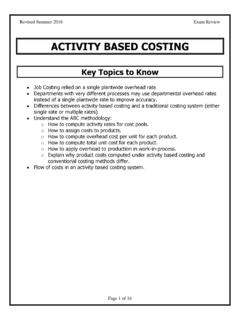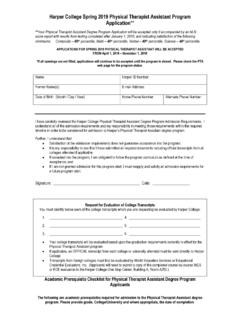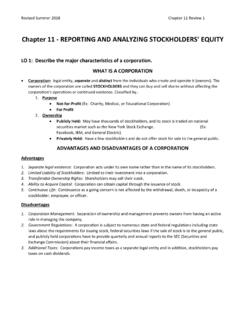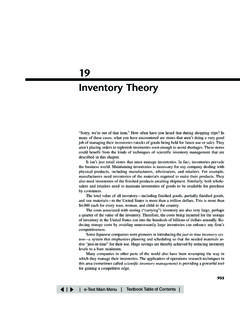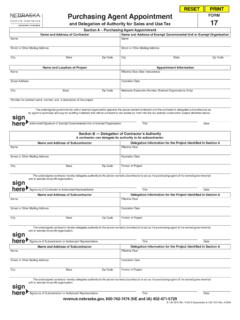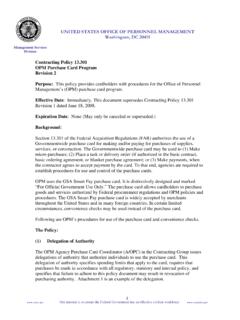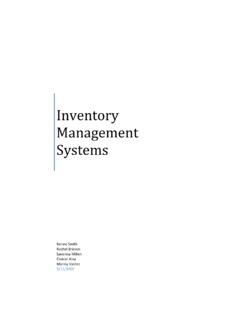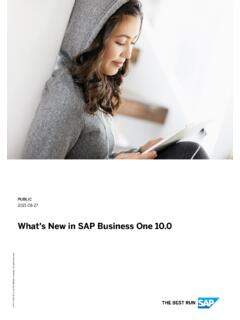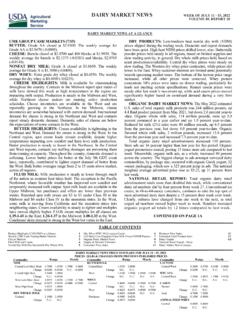Transcription of Revised Fall 2012 - Harper College
1 Revised fall 2012 Page 1 of 25 CHAPTER 4 ACCOUNTING FOR MERCHANDISING OPERATIONS Key Terms and Concepts to Know Income Statements: Single-step income statement Multiple-step income statement Gross Margin = Gross Profit = Net Sales Cost of Goods Sold Gross Margin ratio = Gross Margin / Net Sales Operating Cycle: Purchase merchandise from vendors for inventory on account or for cash Sell inventory to customers on account Collect cash from customers Pay cash to vendors Repeat again and again Note that these steps overlap so that the cash collections from customers may occur before and/or after the cash payments to vendors. Merchandise inventory : Merchandise inventory ( inventory or MI) refers to the goods the company has purchased and intends to sell to others.
2 inventory is a current asset since the company intends to sell it within one year. Cost of Goods Sold: inventory that has been sold becomes an expense, Cost of Goods Sold, in the period of sale. inventory Systems: Perpetual inventory System records all inventory transactions as they occur in the Merchandise inventory account. Perpetual inventory System records all purchase-related inventory transactions as they occur in separate accounts and records the cost of goods sold only at the end of the period. Revised fall 2012 Page 2 of 25 Shrinkage is the cost of inventory not on hand and not sold. It is part of cost of goods sold under either inventory system.
3 purchasing Transactions: inventory account is increased for the cost of the merchandise purchased plus the freight cost necessary to transport the inventory to the buyer s place of business (FOB shipping point). inventory is always recorded at the final cost to the buyer, purchase price less allowances received from the seller and any cash discounts taken Trade discounts are deducted as part of the initial purchase transaction; they are not a purchase discount. Purchase returns: inventory account is decreased for the cost of the merchandise returned to the seller less any allowances or discounts already recorded in the ledger. Sales Transactions: inventory account is decreased and cost of goods sold is increased for the cost of the merchandise sold.
4 The freight cost necessary to transport the inventory to the buyer s place of business is an expense in the period of sale (FOB Destination). Transportation Out or Freight Out are typical accounts used to record the expense. The selling price of the merchandise sold represents revenue to the seller and is recorded in a separate transaction. Trade discounts are deducted as part of the initial sale transaction; they are not a sales discount nor a contra-revenue. Sales Returns: inventory account is increased and cost of goods sold is decreased for the cost of the merchandise returned by the buyer. Sales returns and allowances is increased and cash or A/R is decreased for the selling price of the merchandise returned by the buyer.
5 ALWAYS KNOW WHETHER YOU ARE THE BUYER OR THE SELLER IN THE TRANSACTION. SOME OF THE ACCOUNTS USED AND SOME OF THE DOLLAR AMOUNTS RECORDED WILL DIFFER DEPENDING ON WHETHER YOU ARE THE BUYER OR SELLER IN THE TRANSACTION. Transportation (Freight) Costs: FOB Shipping Point Purchaser is responsible for paying the shipping charges. They are usually prepaid by the seller and added to the invoice. Buyer adds the shipping costs to inventory . If seller prepays, seller has a receivable from buyer. Revised fall 2012 Page 3 of 25 FOB Destination Seller is responsible for paying the shipping charges and they are recorded as the expense Transportation Out. Buyer does not make an entry.
6 Transportation (freight) costs are not subject to a cash discount. Revised fall 2012 Page 4 of 25 Credit Terms: Generally take the form of 2/10, n/30 where - 2 is the discount % - 10 is the discount period in days - n is the net (total) amount to pay - 30 is the number of days after the invoice date that the net amount is due Only purchases are subject to the discount; transportation or freight costs paid by the seller on behalf of the buyer are not subject to a discount. Cash discounts reduce the cost of inventory for the buyer (credit merchandise inventory ) Cash discounts reduce revenue for the seller (debit sales discounts, a contra-revenue account) Acid-Test ratio and Gross Margin ratio Revised fall 2012 Page 5 of 25 Key Topics to Know Note: The same example transactions are presented for Purchase Transactions and Sales Transactions to highlight the differences between cost and selling price.
7 Purchase Transactions When companies purchase goods they intend to sell to customers, the transaction is recorded in the Merchandise inventory account, a current asset. inventory is recorded at cost, which includes the price paid for the goods plus all necessary costs of getting the inventory to the company s place of business and ready to sell. The rules of FOB determine whether freight costs are included in the cost of inventory . Example 1: $800 of inventory is purchased for cash, FOB shipping point. In a separate transaction, the purchaser pays $100 of shipping charges to the shipping company, which are added to the cost of the inventory . Therefore the total cost of the inventory purchased is $800 purchase price + $100 shipping charges: Merchandise inventory 800 Cash 800 Merchandise inventory 100 Cash 100 $200 of merchandise purchased is returned prior to payment.
8 Cash 200 Merchandise Inventory200 Example 2: $800 of inventory is purchased on account, FOB shipping point. The seller pays $100 to the shipping company on behalf of the buyer, which is added to the seller s invoice. The credit terms offered by the seller are 2/10, n/30. Therefore the total cost of the inventory purchased is $800 purchase price + $100 shipping charges: Merchandise inventory 900 A/P 900 $200 of merchandise purchased is returned prior to payment.
9 A/P 200 Merchandise Inventory200 Revised fall 2012 Page 6 of 25 When the invoice is paid within the discount period $800 purchase - $200 return = $600 merchandise * 2% = $12 discount $700 owed ($600 + $100 shipping) - $12 discount = $688 paid A/P 700 Cash 688 Merchandise Inventory12 Example 3: $800 of inventory is purchased on account, FOB destination.
10 In a separate transaction, the seller pays $100 of shipping charges to the shipping company. The buyer records only the cost of the merchandise. The credit terms offered by the seller are 2/10, n/30. Therefore the total cost of the inventory purchased is $800 purchase price. Merchandise inventory 800 A/P 800 $200 of merchandise purchased is returned prior to payment. A/P 200 Merchandise Inventory200 When the invoice is paid within the discount period assuming credit terms of 2/10, n/30.




